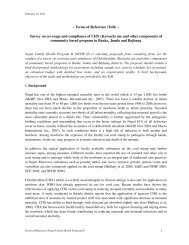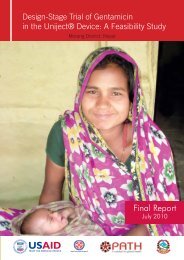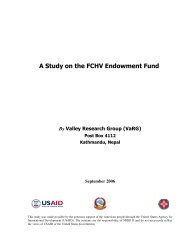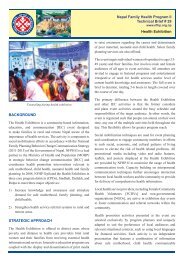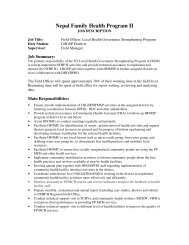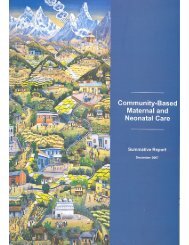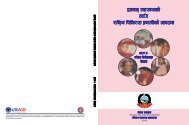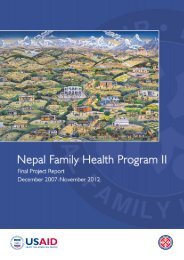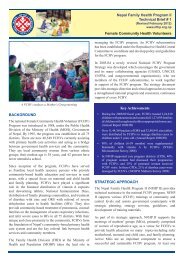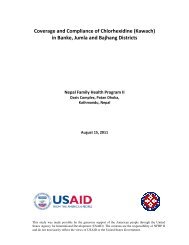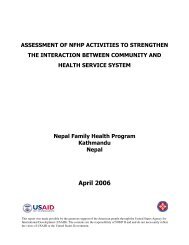(Kawach) in Banke, Jumla and Bajhang Districts - Nepal Family ...
(Kawach) in Banke, Jumla and Bajhang Districts - Nepal Family ...
(Kawach) in Banke, Jumla and Bajhang Districts - Nepal Family ...
Create successful ePaper yourself
Turn your PDF publications into a flip-book with our unique Google optimized e-Paper software.
who had given birth to a liv<strong>in</strong>g baby or had delivered a still born (that had been <strong>in</strong> the<br />
gestation period for at least 28 weeks) <strong>in</strong> the year preced<strong>in</strong>g the survey.<br />
Sample Size<br />
A total of 600 RDW <strong>in</strong> each district were <strong>in</strong>terviewed to gather the data. The sample size of<br />
600 RDW <strong>in</strong> each district was calculated assum<strong>in</strong>g an anticipated rate of 50 percent, with a<br />
marg<strong>in</strong> error of 5 percent, confidence level at 95 percent <strong>and</strong> design effect of 1.5 percent.<br />
Sample Design<br />
The sample design <strong>in</strong>cluded a stratified two-stage cluster sampl<strong>in</strong>g with selection of<br />
households through r<strong>and</strong>om sampl<strong>in</strong>g at the f<strong>in</strong>al stage, provid<strong>in</strong>g a population-based<br />
probability sample of households. The entire VDCs of each of the three districts were<br />
<strong>in</strong>cluded <strong>in</strong> the sampl<strong>in</strong>g frame to ensure a representative result <strong>in</strong> each district. First, the<br />
clusters were identified follow<strong>in</strong>g Population Proportion to Size (PPS) method <strong>and</strong> the<br />
identified clusters were then segmented (3 to 5) by mapp<strong>in</strong>g. F<strong>in</strong>ally, the required numbers of<br />
RDW were recruited from those segments <strong>in</strong> the each cluster.<br />
First Stage: Selection of Clusters<br />
The first stage of the sampl<strong>in</strong>g design <strong>in</strong>cluded the selection of clusters. Wards be<strong>in</strong>g the<br />
smallest adm<strong>in</strong>istrative units <strong>in</strong> <strong>Nepal</strong> were taken as cluster units. All wards of each Village<br />
Development Committees (VDCs) of each district were listed follow<strong>in</strong>g the Population<br />
Proportion to Size (PPS) method <strong>and</strong> 30 wards were selected from each district. For this a<br />
cumulative household population column was prepared us<strong>in</strong>g the recent census data from the<br />
Central Bureau of Statistics. Twenty RDW were recruited from each clusters to make a total<br />
of 600 samples from 30 clusters <strong>in</strong> each district.<br />
Based on New ERA’s past experiences conduct<strong>in</strong>g studies with similar sampl<strong>in</strong>g methods, it<br />
was determ<strong>in</strong>ed that at least 6 households needed to be visited to locate one RDW <strong>in</strong> the<br />
Western Terai (6.2) as well as <strong>in</strong> the Western Mounta<strong>in</strong>s (6.1) 1 . Thus, it was required to visit<br />
120-150 households <strong>in</strong> a cluster <strong>in</strong> each district, <strong>and</strong> it was m<strong>and</strong>atory that each cluster had at<br />
least 150 households. The wards that had less than 150 households were comb<strong>in</strong>ed with their<br />
adjo<strong>in</strong><strong>in</strong>g wards <strong>and</strong> treated as s<strong>in</strong>gle cluster. For this, household size <strong>in</strong> each ward was<br />
thoroughly reviewed, <strong>and</strong> clusters of a m<strong>in</strong>imum of 150 households were formed.<br />
Subsequently, the required number of 30 clusters from each stratum was selected follow<strong>in</strong>g<br />
this method.<br />
Second Stage: Selection of Households<br />
In order to beg<strong>in</strong> household selection, the field team consulted FCHVs <strong>and</strong> local key<br />
<strong>in</strong>formants prior to data collection to prepare a map. The map laid out public places, rivers,<br />
forests, temples, farml<strong>and</strong> <strong>and</strong> so on to locate settlements. The cluster was divided <strong>in</strong>to 3-5<br />
segments with the estimated number of households <strong>in</strong> each segment. The first segment was<br />
chosen r<strong>and</strong>omly from the list of segments to start the data collection.<br />
1 A recent survey of RDW by New ERA for MI <strong>in</strong> <strong>Banke</strong> shows that 6.2 households should be visited to locate a<br />
RDW. Similarly, NDHS (2006) showed 72 RDWs were present <strong>in</strong> 437 sample households <strong>in</strong> Western Mounta<strong>in</strong><br />
Regions, mak<strong>in</strong>g the proportion of household visit of 6.1.<br />
3



